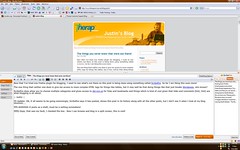
Blogging Process – Find Your Flow
Brian Grenier wrote a blog post back in 2007 that I think I missed where he asks the question how do you write a blog post?
Miguel Guhlin just wrote a great post in response to Brian’s thoughts. In my COETAIL course yesterday we had a great discussion around how blogging was going for those in the class. All of them just 5 weeks into blogging. It was interesting to hear that many of them say blogging as publishing. That they had a lot of drafts waiting to be published but they wanted them to be “perfect” or “publishable”.
“The thought that other can read this, that a future employee can read this makes me want it to be publishable.”
It was great to listen to them talk among themselves and the different feelings they had about being a blogger. They asked me what I thought and along with Miguel talking about how he writes a blog post I thought I’d share my thoughts.
1. Blog topics are all around you You are passionate about something whether teaching, technology, your kids or your car. Be passionate and writing is easy. If your not passionate about the post, or idea, you’ll know cause you just won’t do it.
You are passionate about something whether teaching, technology, your kids or your car. Be passionate and writing is easy. If your not passionate about the post, or idea, you’ll know cause you just won’t do it.
This makes it hard when a teacher (like me) asks you to blog about something you might not be passionate about. That makes blogging an assignment….not real blogging. Real blogging is about you….about your thoughts, your feelings, your ideas…..the blogging you do for classroom, is just classwork.
2. Write down ideas or topics At least two or three times a day I think to myself “that’s a blog topic” and for a while I would sit down to write a blog post and not be able to remember what it was that spurred that moments thought. So I’ve started writing blog topic ideas down. I use the stickies app on my MacBook and Google Tasks via a Chrome extension that lets me quickly jot down topics. I also have a notebook in my backpack for those times when a computer isn’t near to jot stuff down in. Everything from grocery lists, to blog topics. Lastly, I use my iPhone where I have a page of notes that are blog topics. No, you don’t have to have as many places as I do, but I know those are the spots I look for when I have time. Not all ideas make it to a full blog post, some get crossed out, others get folded into each other. It’s the brainstorm phase of writing….just like we teach kids. 🙂
At least two or three times a day I think to myself “that’s a blog topic” and for a while I would sit down to write a blog post and not be able to remember what it was that spurred that moments thought. So I’ve started writing blog topic ideas down. I use the stickies app on my MacBook and Google Tasks via a Chrome extension that lets me quickly jot down topics. I also have a notebook in my backpack for those times when a computer isn’t near to jot stuff down in. Everything from grocery lists, to blog topics. Lastly, I use my iPhone where I have a page of notes that are blog topics. No, you don’t have to have as many places as I do, but I know those are the spots I look for when I have time. Not all ideas make it to a full blog post, some get crossed out, others get folded into each other. It’s the brainstorm phase of writing….just like we teach kids. 🙂
3. Keeping web pages organized
 This came up in class yesterday. How do you keep all those sites open, or organize that you want to talk about in a blog post? In Firefox I use an extension called Tabloc that allows me to ‘Lock’ a tab (still looking for a good one for Chrome is anyone has one!). So if my browser closes or I need to restart those tabs that are locked, stay safe and saved. I also have gotten better at tagging web pages in Diigo and using the highlight features as well. Social bookmarking takes time to understand and time to find out how tagging works and how to use it for you. I have a system that works for me and I’m going on 5 years without using bookmarks within my browser…..everything is in Diigo and Delicious (which are connected so when I save to Diigo it auto-saves it to Delicious….a perfect backup system!)
This came up in class yesterday. How do you keep all those sites open, or organize that you want to talk about in a blog post? In Firefox I use an extension called Tabloc that allows me to ‘Lock’ a tab (still looking for a good one for Chrome is anyone has one!). So if my browser closes or I need to restart those tabs that are locked, stay safe and saved. I also have gotten better at tagging web pages in Diigo and using the highlight features as well. Social bookmarking takes time to understand and time to find out how tagging works and how to use it for you. I have a system that works for me and I’m going on 5 years without using bookmarks within my browser…..everything is in Diigo and Delicious (which are connected so when I save to Diigo it auto-saves it to Delicious….a perfect backup system!)
4. Find a blogging interface that works for you. There are many different blogging interfaces that you can use to actually write your blog post in. I’m a huge fan, and honestly would have a hard time blogging without ScribeFire (Firefox Add-on). I’ve tired to blog just using WordPress and visually it just doesn’t do it for me. I know that many people use the Flock Web Browser and find the built in blogging application very good (I think it’s my second favorite). Scribefire is the only reason I still use Firefox. My day to day browsing has moved to Chrome and I find that I don’t blog as much because it means going someplace else to write. That’s what I love about ScribeFire, it’s just there, in your browser waiting for you to start writing.
There are many different blogging interfaces that you can use to actually write your blog post in. I’m a huge fan, and honestly would have a hard time blogging without ScribeFire (Firefox Add-on). I’ve tired to blog just using WordPress and visually it just doesn’t do it for me. I know that many people use the Flock Web Browser and find the built in blogging application very good (I think it’s my second favorite). Scribefire is the only reason I still use Firefox. My day to day browsing has moved to Chrome and I find that I don’t blog as much because it means going someplace else to write. That’s what I love about ScribeFire, it’s just there, in your browser waiting for you to start writing.
Take time to try out a couple blogging applications and see if one fits you and your style. You gotta be comfortable with your flow of thought, writing, and idea process otherwise writing will become a chore not a pleasure.
5. Finding your Flow In the end….I think it’s about finding your flow. Some people blog at the same time every day. I know Kim Cofino (cause we talk about this kind of stuff in the office) does most of her blogging on the weekend, because that’s what works for her. I found that I need it cool, I blog better, ideas flow when I’m in a cooler temperature. So I either blog in my home office with the A/C on or here on the couch with a fan blowing on me to keep me cool. I didn’t realize this was an issue for a long time here in Bangkok. It’s only been about 6 months that I realize I don’t write because I’m uncomfortable, hot, sticky, and not in a thinking mode.
In the end….I think it’s about finding your flow. Some people blog at the same time every day. I know Kim Cofino (cause we talk about this kind of stuff in the office) does most of her blogging on the weekend, because that’s what works for her. I found that I need it cool, I blog better, ideas flow when I’m in a cooler temperature. So I either blog in my home office with the A/C on or here on the couch with a fan blowing on me to keep me cool. I didn’t realize this was an issue for a long time here in Bangkok. It’s only been about 6 months that I realize I don’t write because I’m uncomfortable, hot, sticky, and not in a thinking mode.
Find your flow, find which time/day works for you, what place, which application. Take time to try things out. I’m constantly looking for another blogging application to replace ScribeFire and just haven’t found one that I like better…that enhances my flow of ideas and process of writing.
6. Write to your community ~ Know your audience A
A blog website whether you like it or not is about branding. Your audience want’s to know what they are going to get when they go to your site. You know what to expect when you go to CNN, BBC, NYTimes, TechCrunch, Mashable, etc. Your blog needs to have a focus. That doesn’t mean you can’t go off topic once in awhile, but the majority of your blog posts should be to a specific audience. I focus broadly on education and specifically on educational technology. But I also talk about my love of baseball and travel as well……after all it is my site. 😉
So that’s it…find your flow, find your audience and blogging can be enjoyable.








The blog discussion yesterday was very helpful. It was especially helpful to learn that a blog post does not have to have a nice neat ending but can end up in the air with a request for help or feedback. Just wish I had know that earlier.
You’re only 5 weeks into blogging…..I think you’ve learned it pretty early on in your blogging career. We’ll continue discussing it in class, as it’s an interesting topic that I don’t think has one right answer.
[…] Goes Nothing! 14 03 2010 I have to wonder if I came to mind as Jeff wrote this. I don’t know if I should flatter myself and think of myself as his temporary muse or be […]
Nice article here! Agree highly with many of your points and love that you made sure that blogging starts with your passion!! People don’t really understand this. They want to blog and try to make money so they jump into something for the money and not their passion. You are setting yourself up to fail.
Also, knowing your niche and your audience within your niche is huge. Once you find your passion, crunch down to the smallest niche within your passion as possible. That is the best way to get a true passionate group of followers. Its not all about the high numbers. It is about the quality followers who will truly listen to what you have to say and recommend.
[…] second blog post that got my attention was by Jeff Utech from his blog called The Thinking Stick on “The Blogging process: find the flow”. Â I am going to try and do what Jeff […]
[…] enough good things about this blog). This time, the top post on Jeff Utecht’s blog is entitled, Blogging Process – Find Your Flow! (Too perfect, […]
I myself was very confused at the start of Dr.Strange’s EDM310 class. I was like, “blogging uh…..”, but now I like it. As of right now I only blog as part of my assignments but I don’t see myself ever stopping because it’s a great leaning tool and like you said you can talk about anything. At first I couldn’t find anything to say and now I have a list of topics to write about on my on blog.
I LOVE that the kids were considering the consequences of blogging, or “publishing” in their words. It shows that they get the public and semi-permanent nature of web posting. They should be encouraged to keep this mindset, as employers, legal entities, and even Big Brother might be taking notice.
[…] Share this on del.icio.us […]
[…] The Thinking Stick – Blogging Process, Find Your Flow […]
Jeff, Great points on blogging. I am wondering what blog platform you use with your students. What do they use as an e-mail address as I’ve been told that students under age 13 are not supposed to have their own addresses. Thanks, Susan
Great post Jeff. I was very interested to hear about what you do AFTER you post to your blog or in other words, how you promote you posts.
Believe it or not, I’m a firefox user and have never heard of ScribeFire. I installed it and it’s pretty cool. I’ll test it out. Thanks for the tip.
I usually just send my blog ideas to myself via email and write all my posts in a regular text editor. Not as sophisticated as most, but it gets the job done. However, I’ll give scribefire a go. I write a lot of my idea offline. Not sure if scribefire will allow me to post blog ideas while offline.
Thanks for the post Jeff!